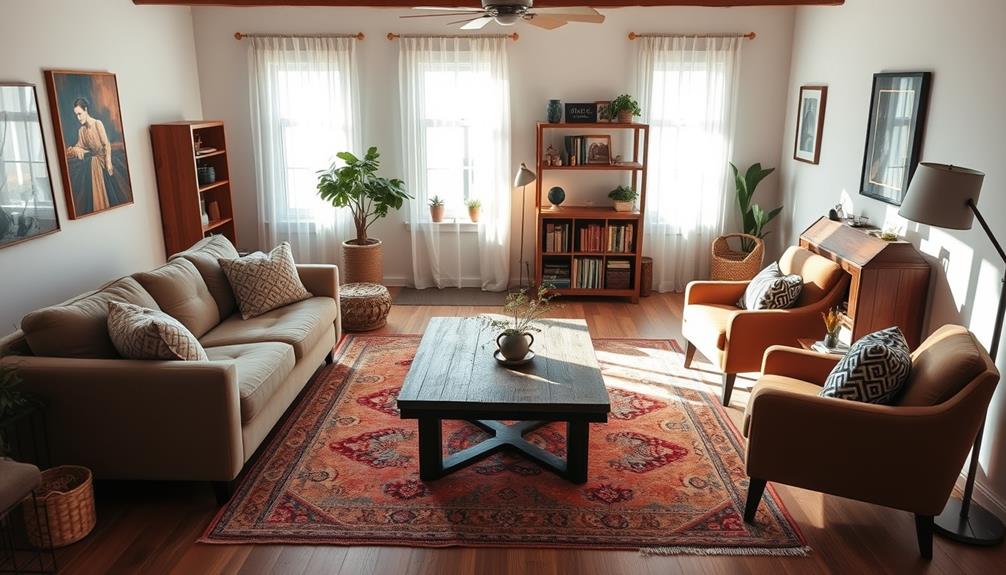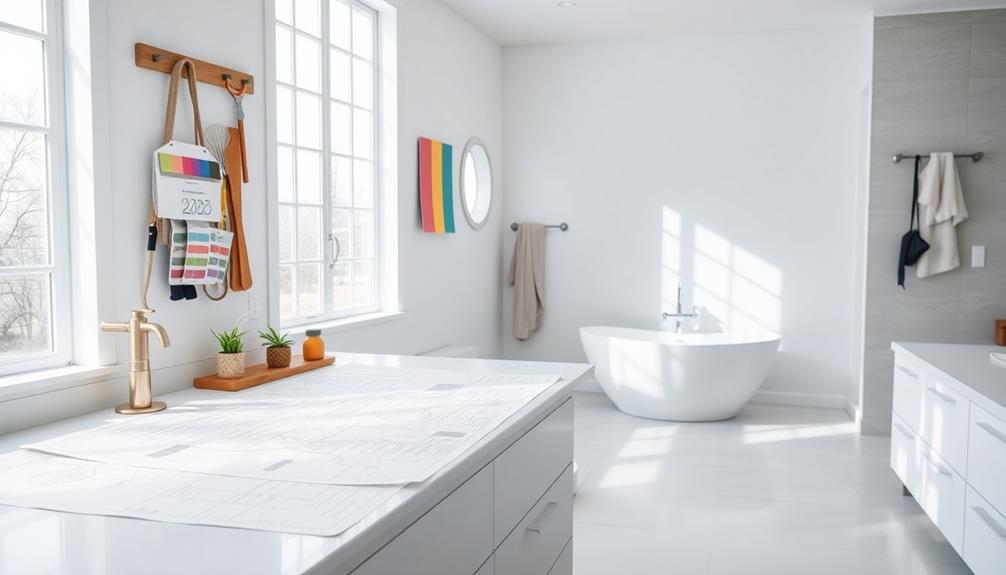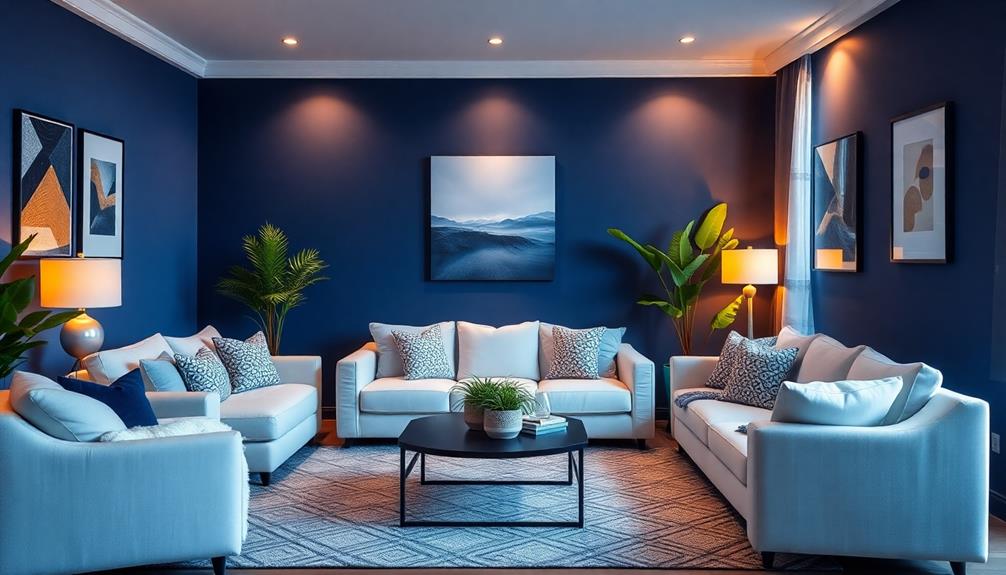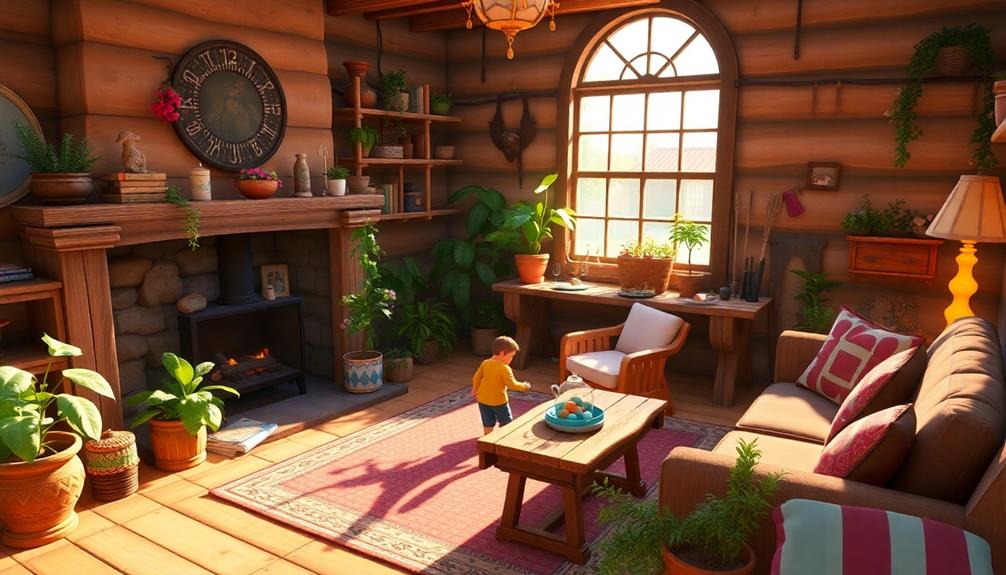Organizing your living room furniture strategically can help you create a functional and inviting space. Start by selecting a layout that complements your room, such as an L-shaped or floating arrangement. Ensure that seating is arranged to face each other to encourage smooth conversation flow. Utilize area rugs to define different sections and add a sense of intimacy. Focus on a focal point, such as a fireplace or piece of artwork, to guide your layout. Make sure there is enough space, around 18 inches between seating and coffee tables, to allow for easy movement. If you have a smaller room, consider using multi-functional furniture to maximize space. There’s much more to discover about optimizing your living room!
Key Takeaways
- Identify a focal point and arrange seating to face it, enhancing comfort and visual appeal.
- Utilize a balanced layout, like symmetrical or L-shaped arrangements, to optimize space and flow.
- Create conversation areas by placing seating pieces in close proximity, maintaining around 8 feet between them.
- Use area rugs to define distinct zones, enhancing functionality and aesthetics in your living room.
- Incorporate multi-functional furniture to maximize space and ensure versatility in small living areas.
Importance of Floor Plans
When arranging your living room, having a solid floor plan can make all the difference. Floor plans enhance the functionality of your space by providing a clear visual representation of furniture placement and room flow. By mapping out furniture arrangements—using tools like the Homestyler app or even painter's tape—you can better understand spatial relationships, optimizing your living room layouts. Incorporating insights from mood boards essential can also help in visualizing how different elements work together.
Versatile arrangements can adapt to various room shapes and sizes, allowing you to find creative solutions that meet your personal needs and preferences. A well-designed floor plan facilitates better conversation areas, ensuring all seating is comfortably positioned for accessibility. This thoughtful furniture arrangement not only promotes social interaction but also prevents overcrowding.
Moreover, a properly executed floor plan improves traffic flow, making it easy to navigate your living room without obstructions. Area rugs can further define spaces, enhancing both functionality and aesthetic appeal.
Ultimately, investing time in crafting a solid floor plan helps you create a living room that's not only beautiful but also practical, reflecting your lifestyle while providing a welcoming atmosphere for family and friends.
Popular Furniture Layouts
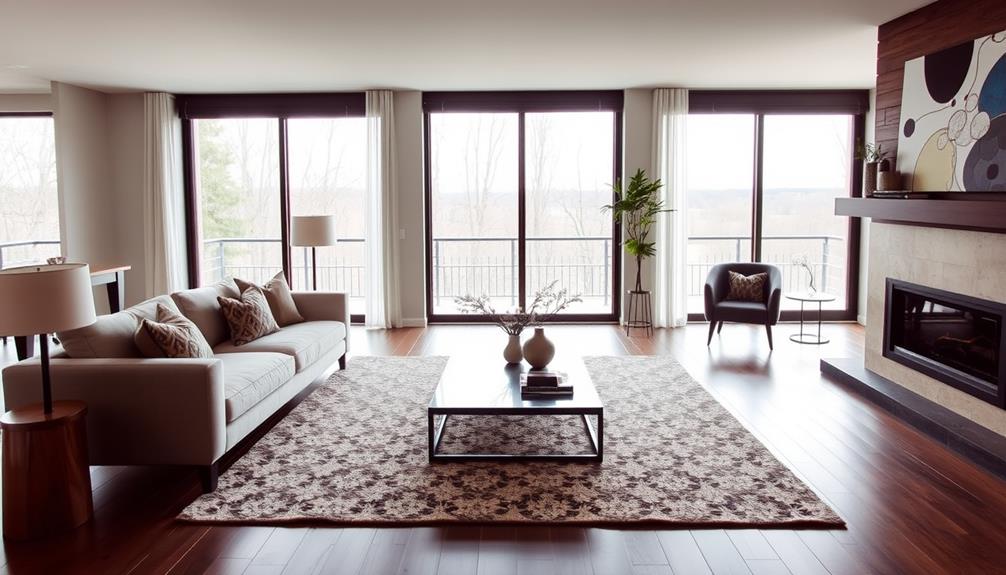
Having a solid floor plan lays the groundwork for exploring popular furniture layouts that can elevate your living room's design.
First, consider the Symmetrical Layout, where you place matching sofas or chairs opposite each other, creating an orderly and balanced look. This arrangement works well in larger spaces and can be enhanced with natural materials like wood and stone for a more inviting atmosphere.
If your living room has corners, the L-shaped Layout is ideal; it utilizes wall space efficiently while encouraging conversation among guests.
For a more dynamic feel, try the Floating Layout. Here, you position your main seating away from the walls, forming a central conversation area that promotes interaction.
Alternatively, the U-shaped Layout, featuring two sofas facing each other, offers ample seating and intimacy, perfect for social gatherings.
Lastly, don't overlook the Diagonal Layout. Arranging furniture at an angle can enhance the room's dimensions and draw attention to architectural features, creating a unique flow.
Each of these furniture layouts serves different purposes, so choose one that aligns with your lifestyle and enhances your living room's overall design.
Creating Conversation Areas
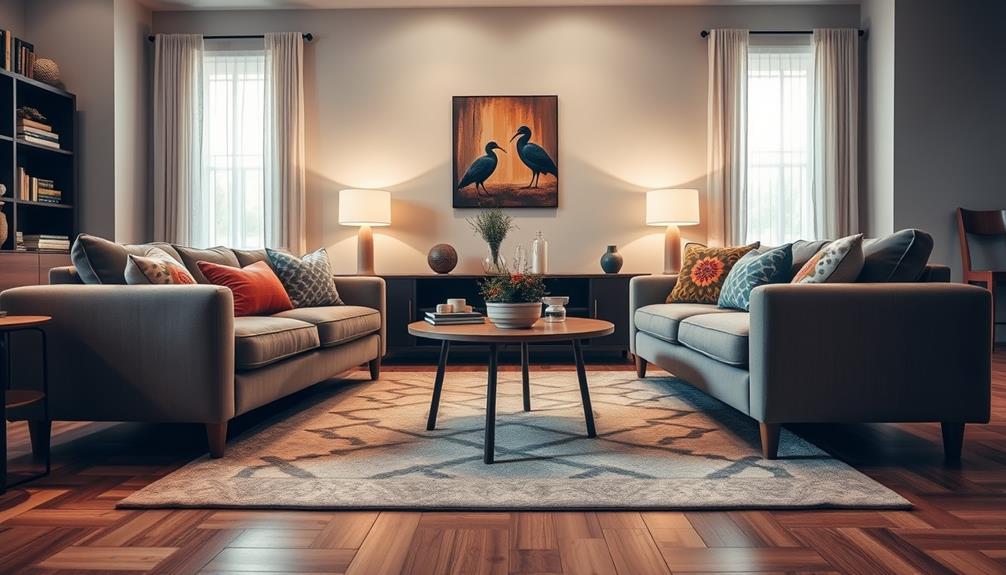
Creating inviting conversation areas in your living room is key to fostering interaction among guests. Start by arranging your seating pieces—like sofas and chairs—to face each other. This setup encourages natural engagement and makes conversations more enjoyable.
Maintaining curiosity about your guests and their interests can enhance these interactions, contributing to a more fulfilling social experience, as curiosity often boosts mental health by fostering a positive mindset. Keep the distance between the seating pieces within 8 feet to facilitate comfortable dialogue without straining to hear.
Incorporate a coffee table in the center of this arrangement, ensuring there's about 18 inches of space around it for easy access and movement. Instead of placing furniture in a straight line, opt for angled seating to create a more inviting atmosphere that truly encourages conversation.
If you have a larger room, consider dividing the space into multiple conversation zones. This allows for more intimate gatherings and varied interactions among guests.
Focal Points in Design
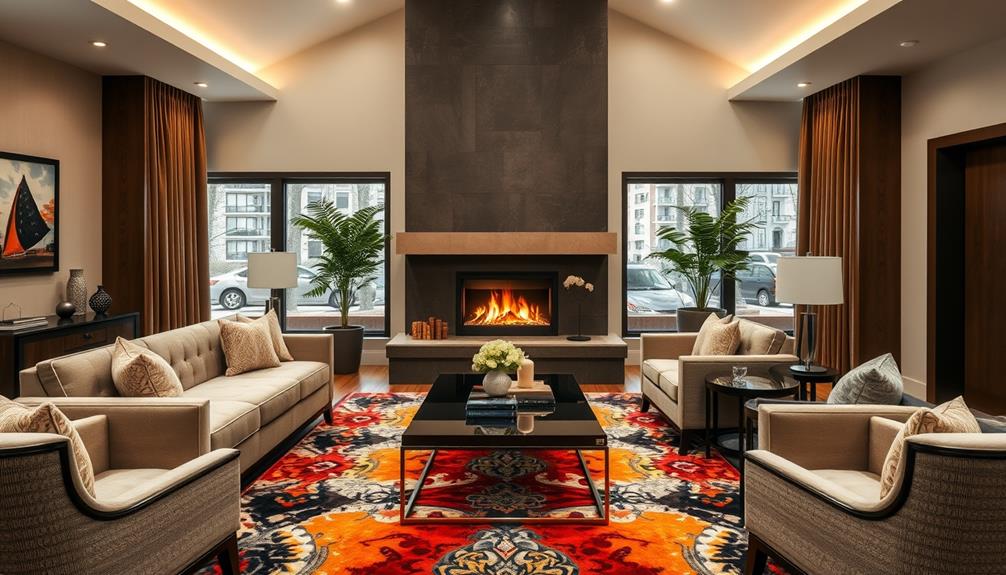
A well-defined focal point can transform your living room into an enchanting space that draws the eye and organizes the surrounding furniture. The focal point serves as the central element around which your furniture arrangement revolves, enhancing visual appeal and functionality.
When choosing a focal point, consider both natural and created options. Natural focal points, like a fireplace or large windows, guide your layout, while created focal points, such as a TV or artwork, should be positioned for ideal viewing. Avoid multiple competing focal points to maintain a cohesive design.
Here's a quick comparison of focal point options:
| Type | Examples |
|---|---|
| Natural Focal Points | Fireplace, Large Windows |
| Created Focal Points | TV, Artwork, Statement Piece |
Arrange your seating area to face the chosen focal point, fostering a comfortable atmosphere that encourages conversation. Remember the height of the focal point; items like TVs or artwork should be at or slightly above eye level from your seating. This guarantees a pleasant viewing experience and enhances the overall flow of your living room.
Tips for Small Spaces
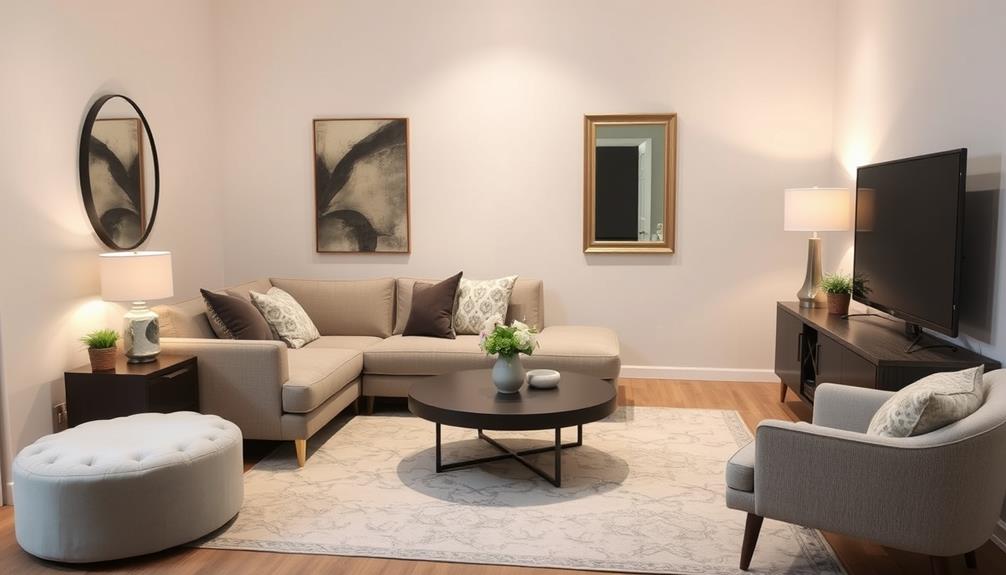
When designing a living room, especially in smaller spaces, maximizing functionality while maintaining style is essential. Start by choosing multi-functional furniture like storage ottomans or sofa beds. These pieces not only save space but also enhance the room's usability.
Instead of pushing furniture against walls, create a central arrangement. This approach opens up the room and fosters a cozy atmosphere.
Opt for lightweight chairs and smaller-scale furniture instead of bulky sofas. This makes the small living room feel more inviting and less cramped.
To define distinct seating zones, use area rugs strategically. Make sure the front legs of your furniture rest on the rug to create a cohesive look.
Incorporating vertical storage solutions like tall bookshelves or wall-mounted shelves is vital. These options save valuable floor space while keeping your room organized and visually appealing.
By thoughtfully arranging furniture and choosing the right pieces, you can transform your small living room into a functional and stylish haven.
Frequently Asked Questions
How to Layout Furniture in a Living Room?
To layout furniture in a living room, start by identifying the focal point. Position your largest piece towards it, use area rugs for zones, and maintain space between items to encourage movement and conversation.
Where to Place a Sofa in a Living Room?
Picture your sofa as the sun, radiating warmth and inviting conversation. Place it facing your room’s focal point, ensuring it doesn’t block windows or crowd other furniture, creating space for movement and light. Consider the arrangement of additional seating to complement your sofa, like accent chairs that encourage engagement. When exploring sofa placement tips for living rooms, remember to maintain a balance between functionality and aesthetics, allowing for easy navigation throughout the space. A well-placed sofa not only enhances the room’s design but also fosters a welcoming atmosphere for friends and family to gather.
How Should the Furniture Be Arranged?
To arrange your furniture effectively, start with the largest piece facing the focal point. Position seating to encourage conversation, define zones with rugs, maintain clear pathways, and balance visual weight for a harmonious layout.
Where to Put TV in Living Room With Windows?
You should place the TV opposite your main seating area, ensuring it's at eye level. If windows cause glare, angle the TV or use curtains to control light and maintain comfortable viewing.
Conclusion
To sum up, arranging your living room furniture can transform your space into a stylish sanctuary. By focusing on floor plans, fostering conversation, and featuring focal points, you'll create a cozy and enchanting environment. Don't forget to reflect on clever solutions for small spaces, too! So, take the time to tweak and tailor your layout, and you'll find that a thoughtfully arranged room will not only look great but also feel fantastic for you and your guests. Remember, the key to a successful living room arrangement lies in careful planning and strategic placement. Similarly, when it comes to updating your bathroom, considering essential steps for bathroom remodel is crucial. From selecting the right fixtures to maximizing storage space, these steps can help you create a functional and beautiful space that meets all your needs. So, whether you’re revamping your living room or renovating your bathroom, thoughtful consideration and attention to detail will make all the difference in creating a space that is both comfortable and visually pleasing.
